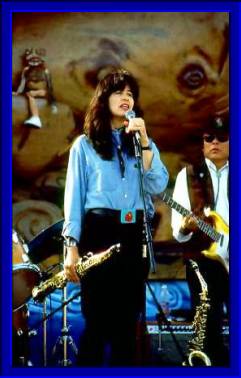LITR 5535: American
Romanticism

Student Poetry Presentation 2006
Monday 25 September:
poetry: Joy Harjo, "Call It Fear," N 2834-5
poetry reader / discussion leader: Dee Ann Bongiovanni
Joy Harjo

Biographical Information Related to American
Romanticism:
Joy Harjo has
an M.F.A and has taught at several universities in the western part of the
United States. Her family
background is relevant to interpreting the romantic elements of her poem
because her heritage illuminates one of the ideas in objective two:
“Americans are racially divided and historically related.”
Harjo’s
mother is of Cherokee, French, and Irish heritage; her father was a member of
the Creek tribe; her paternal grandfather was a Baptist minister; and parental
great grandfather led a Creek rebellion against the forced removal of the
Creek people from Alabama to Oklahoma in 1832.
Harjo’s
heritage and poetry directly relate to our current readings. Written shortly
before Harjo’s great grandfather led the Creek rebellion, the author of
“Memorial of the Cherokee Citizens, December 1829,” writes about “our
hearts” in a similar vein that Harjo writes about “our hearts” in
“Call it Fear.” Both writers are trying to reconcile what they see as
inconsistencies with Christianity.
Nine years
after writing “Call it Fear,”
in an interview published in The
Kenyon Review, Harjo stated, “It has taken me years to divest myself of
Christian guilt, the Puritan cloud that provides the base for the culture of
this country…or at least to recognize the twists and turns of the illogic in
my own sensibility.”
Timeline from
The Last of the Mohicans to “Call it Fear”
|
1826 |
The
Last of the Mohicans first published |
Romantic
Idealism |
|
1829 |
“The
Cherokee Memorials” to the Senate and House of Representatives of
the United States |
Reality
that Christianity conflicts with the Indian Removal Act |
|
1830 |
Indian
Removal Act |
Reality |
|
1832 |
Joy
Harjo’s great-grandfather leads a Creek rebellion against forced
removal |
Reality |
|
1983 |
Joy
Harjo writes “Call it Fear” |
“Inward
journey through personal and collective memory.” |
Call it Fear
There is this edge where shadows
and bones of some of us walk
backward
Talk backward.
There is this edge
Call it an ocean of fear of the dark.
Or
name it with other songs.
Under our ribs
our hearts are bloody stars.
Shine on
shine on, and horses in their
galloping flight
strike the curve of ribs.
Heartbeat
and breathe back sharply.
Breathe
backwards.
There is this edge within me
I saw it once
an August Sunday morning when the heat
hadn’t
left the earth.
And Goodluck
sat sleeping next to me in the truck.
We had never broken through the edge
of the
singing at four a.m.
We had only wanted to talk, to hear
Any other voice to stay alive with.
And there was this edge—
not the drop of sandy rock cliff
bones of volcanic earth into
Albuquerque
Not that,
But
a string of shadow horses kicking
and pulling me out of my belly,
not into the Rio Grande but into the music
barely coming through
Sunday church singing
from the radio.
Battery worn-down but the voices
Talking backward.
Interpretation
of Romantic and Non-Romantic Qualities:
“Call
it Fear” is a modern lyric: a short song-like poem that emphasizes personal
feelings. The majority of Harjo’s
poem embodies ideas of Romanticism, such as desire and rebellion, and
incorporates romantic motifs, such as the gothic style.
Fear is an edge that her spirit, symbolized by the horses, has a desire
to break through. The horses are both “in their galloping flight,” thus
attempting to run free and a “shadow of horses kicking / and pulling” her
out of “her belly,” thus a gothic-type ghost, ripping out her guts.
Her spirit is identifiably American because it represents the conflicts
associated with a desire for freedom. Harjo,
specifically, expresses a desire to be free from the fear of oppressive ideas
that are represented by the “Sunday church singing.” At the end of the poem, she magnifies Romanticism by using
contrast. She inserts the mundane,
realistic image of a radio with a worn down battery, then she ends on the
haunting, romantic note of the voices “talking backward.”
________________________________________________________________
Objective 1a. Romantic Spirit or Ideology: To describe,
identify, and criticize attitudes associated with Romanticism, such as
rebellion.
In Native American culture there is a sacred spirit that does things backwards, which forces people to examine their doubts, fears, etc. What do you think the spirit’s purpose is in showing the romantic idea of rebellion?
_______________________________________________________________
Objective
1c: Romantic Genres: To describe and evaluate leading literary genres of
Romanticism, such as the romance narrative (a journey from repression to
transcendence).
“Call
it Fear” is part of a collection of poems entitled She
had Some Horses.
The collection is a journey from repression to transcendence, where do you think this poem fits in that romantic journey? Do you see the beginnings of transcendence as it relates to Romanticism in “Call it Fear?”
_______________________________________________________________
Objective
1c: Romantic Genres: To describe and evaluate leading literary genres of
Romanticism, such as the Gothic style (haunted physical and mental spaces, the
shadows dark and light).
Where do you
see the Gothic style in the poem?
______________________________________________________________
Objective 2: Cultural Issues: To identify Americans as racially
divided, but historically related people who develop “Old and New Canons” of
romantic literature.
Do you think Joy Harjo’s work is part of a “New Canon” of romantic literature?
________________________________________________________________
Additional Question
Harjo is an accomplished jazz musician,
are there any places in the poem where romantic qualities are evident in the
rhythm of her words, such as her use of onomatopoeia.
|
|
|
|

